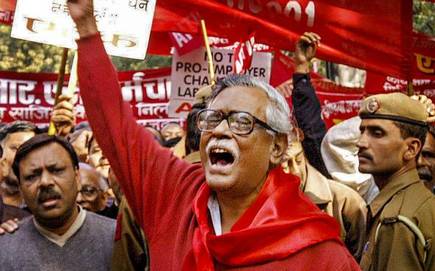Veteran trade unionist Gurudas Dasgupta dies at 83
 NEW DELHI : Veteran trade unionist, senior leader of Communist Party of India (CPI) and a skilled Parliamentarian, Gurudas Dasgupta passed away in his south Kolkata residence from a prolonged illness. He was 83.
NEW DELHI : Veteran trade unionist, senior leader of Communist Party of India (CPI) and a skilled Parliamentarian, Gurudas Dasgupta passed away in his south Kolkata residence from a prolonged illness. He was 83.
Veteran trade unionist, senior leader of Communist Party of India (CPI) and a skilled Parliamentarian, Gurudas Dasgupta passed away in his south Kolkata residence from a prolonged illness. He was 83.
His death came even as the federations of unions affiliated to his party — the AITUC — is celebrating its hundredth birthday in Mumbai. In the recent decades Dasgupta, was perhaps the best known mascot of the AITUC, the oldest trade union in the country. He was the AITUC general secretary for 17 years.
Born in Barishal, now in Bangladesh, Dasgupta started his political career in a south Kolkata college. In 1952, in his mid-teens, he got membership to the undivided Communist Party — an achievement considering that he came from a predominantly Congress family.
Few years later, in 1958 he became the president and general secretary of the Bengal Provincial Students’ Federation (BPSF). From 1967 to 1977 he was a member of the West Bengal Committee of All India Youth Federation.
His relationship with the Congress remained complex and hit a low during the pre-emergency days when under the stewardship of Biswanath Mukherjee, he resisted the CPI’s decision to back Congress. He was actively involved in the inner party struggle and played a pivotal role in opposing the party line; but never left the party.
He was the first among the major leftist leaders to indicate — quoting economist Joseph Stiglitz — that the Congress driven neo-liberal economy would “only boost jobless growth.”
“In lecture after lecture and through write ups, Gurudasda warned the Congress. [He] told them that the economic disequilibrium-led void created by the neo-liberal economy can only be filled by extreme right wing forces. He was perhaps one of the early leaders to connect the ill-effects of neo-liberal economy and the rise of the right. What sounded like a theory two decades back…appears like a prophecy now,” said Tamonash Bhattacharya, a long time associate.
Dasgupta also suggested the creation of “political hegemony” of Left on the lines of Antonio Gramsci and argued that the Leftist movement should be able to “influence” movements in States neighbouring West Bengal, which the Left parties could not.
However, Dasgupta never wanted to bypass Parliament and was a champion of democratic principles — from contesting in elections to relentlessly debating in Parliament. Dasgupta was elected thrice to Rajya Sabha — in 1985, 1988 and 1994 — and twice to the Lok Sabha in 2004 and 2009.
Industry big wigs, it was said, would run for cover to avoid being the “centre” of his attention, for they knew his tenacity and reach to take matters to their logical conclusion. His tenacious pursuit of justice for the workers is exemplified in his efforts to ensure statutory payment by the jute industry. His high-pitched campaign through the media and efforts with the authorities forced the industry to clear dues and pay the hapless workers. “Otherwise the law will take its course,” he would thunder.
He was one of the most respected leaders of the bank employees unions and even headed many trade unions of private sector companies. Dasgupta exposed the financial scams of the Nicholas Piramal Group during his earlier years in the House. He remained a staunch opponent of the illegal operation of the Bailadila Coal Mines in Chattisgarh, including a Parliamentary probe — a reason why the CPI is still a force in south Chattisgarh.
From the Harshad Mehta driven securities scam of 1992 to the 2G scam of 2007, Dasgupta was pitiless in raising dozens of financial irregularities in the floor of the House. It was often said that without Dasgupta’s campaigns against corruption, it would have been far more difficult to weaken the Congress, which eventually catapulted the BJP to power.
Dasgupta also prime mover to identify, unearth and bring back black money in the 1990s. He was rewarded financially for his endeavour by the government but donated the entire amount to the orphans whose parents had been killed during the Khalistan movement in Punjab.
In his condolence message, Prime Minister Narendra Modi said Dasgupta “was one of the most committed and articulate proponents of his ideology.” He was indeed a “strong voice in Parliament, whose interventions were keenly heard across the political spectrum,” the Prime Minister tweeted.
His death came even as the federations of unions affiliated to his party — the AITUC — is celebrating its hundredth birthday in Mumbai. In the recent decades Dasgupta, was perhaps the best known mascot of the AITUC, the oldest trade union in the country. He was the AITUC general secretary for 17 years.
Dasgupta started his political career in a south Kolkata college. In 1952, in his mid-teens, he got membership to the undivided Communist Party — an achievement considering that he came from a predominantly Congress family. Few years later, in 1958 he became the president and general secretary of the Bengal Provincial Students’ Federation (BPSF). From 1967 to 1977 he was a member of the West Bengal Committee of All India Youth Federation. Dasgupta’s last rites will take place on Friday.
(With Agency Inputs ).

